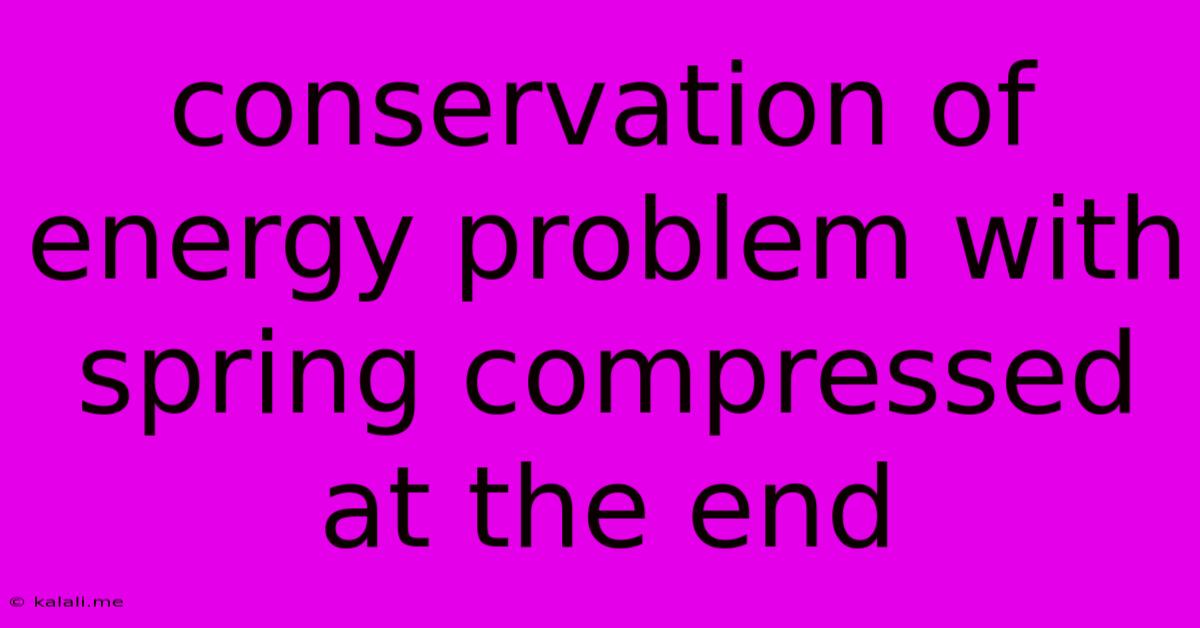Conservation Of Energy Problem With Spring Compressed At The End
Kalali
May 30, 2025 · 3 min read

Table of Contents
Conservation of Energy Problem: A Compressed Spring at the End
This article explores a classic physics problem: the conservation of energy in a system involving a spring compressed at one end. We'll delve into the concepts, the calculations, and the practical implications. Understanding this problem is fundamental to grasping energy transformations and the principles of mechanics. We will examine both simple and more complex scenarios involving different factors such as friction and various spring configurations.
Understanding Conservation of Energy
The principle of conservation of energy states that energy cannot be created or destroyed, only transformed from one form to another. In a closed system, the total energy remains constant. This principle is crucial for solving problems involving springs, which store potential energy that can be converted into kinetic energy (energy of motion).
The Basic Scenario: A Simple Spring System
Imagine a mass m attached to a spring with spring constant k. The spring is compressed a distance x from its equilibrium position and then released. Initially, all the energy is stored as elastic potential energy in the compressed spring:
PE<sub>spring</sub> = 1/2 * k * x<sup>2</sup>
As the spring releases, this potential energy is converted into kinetic energy of the mass:
KE = 1/2 * m * v<sup>2</sup>
According to the conservation of energy, at any point during the motion (ignoring friction), the sum of the potential and kinetic energy remains constant:
PE<sub>spring</sub> + KE = Constant
Therefore, we can determine the velocity of the mass at any point in its motion by equating the initial potential energy to the kinetic energy at that point. At maximum compression (x), velocity is zero. At maximum extension (-x), the velocity will again be zero. The maximum velocity will be found at the equilibrium position (x = 0).
Adding Complexity: Friction and Other Forces
In a real-world scenario, friction and other dissipative forces will inevitably be present. These forces convert some of the mechanical energy into thermal energy (heat), reducing the kinetic energy of the mass. This means the final velocity will be lower than predicted by the ideal, frictionless model. Calculating the impact of friction requires knowing the friction coefficient and incorporating it into the energy equation. The energy equation will now include a term representing the work done by friction.
Advanced Scenarios: Multiple Springs and Inclined Planes
The problem becomes more complex when multiple springs are involved or when the system incorporates an inclined plane. In the case of multiple springs connected in series or parallel, the effective spring constant needs to be calculated first, before applying the conservation of energy principle. When dealing with an inclined plane, the potential energy will include both gravitational potential energy and elastic potential energy. The energy equation would then include the changes in gravitational potential energy as well. The angles and distances involved need careful consideration in these situations.
Solving Conservation of Energy Problems: A Step-by-Step Approach
- Identify the system: Clearly define the boundaries of the system under consideration.
- Identify the types of energy: Determine the types of energy involved (kinetic, potential, thermal).
- Apply the conservation of energy principle: Write an equation equating the initial total energy to the final total energy. Remember to account for any energy losses due to friction or other dissipative forces.
- Solve for the unknown: Use the equation to solve for the unknown variable (e.g., velocity, displacement, spring constant).
By understanding the principles of conservation of energy and applying these steps systematically, you can solve a wide range of problems involving compressed springs, mastering a fundamental concept in physics. Remember to always consider the limitations of the model and the impact of real-world factors like friction. This detailed understanding allows for more accurate predictions and a deeper comprehension of energy transformations in mechanical systems.
Latest Posts
Latest Posts
-
I Think My Son Knows I M Not His Biological Father
May 31, 2025
-
How To Convince Someone To Do Something
May 31, 2025
-
How To Spell Neil In Soccer
May 31, 2025
-
How To Keep Critters Out Of A Garden
May 31, 2025
-
How To Turn On A Gas Oven
May 31, 2025
Related Post
Thank you for visiting our website which covers about Conservation Of Energy Problem With Spring Compressed At The End . We hope the information provided has been useful to you. Feel free to contact us if you have any questions or need further assistance. See you next time and don't miss to bookmark.